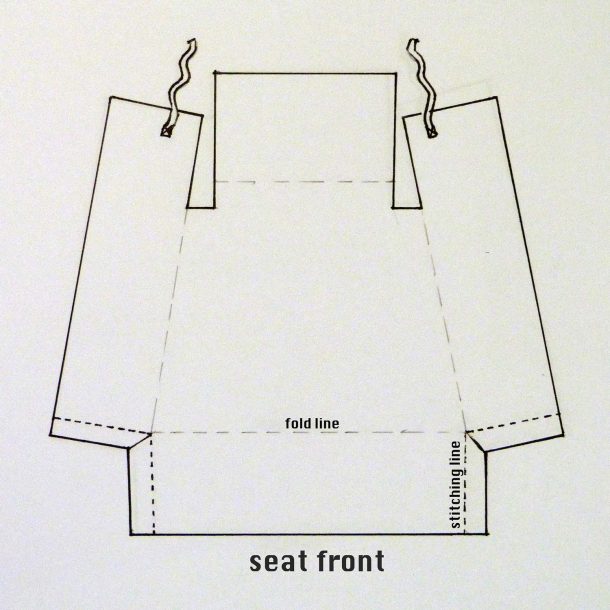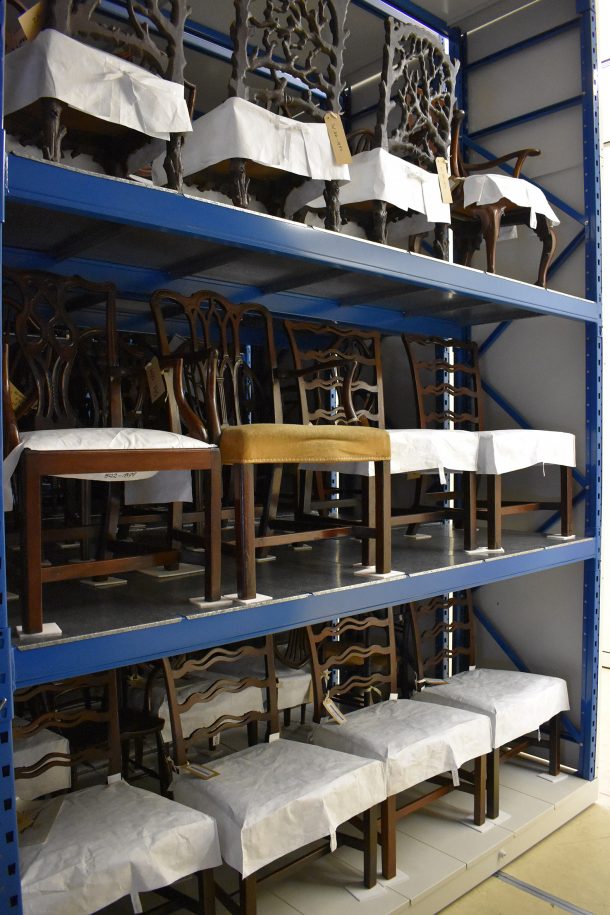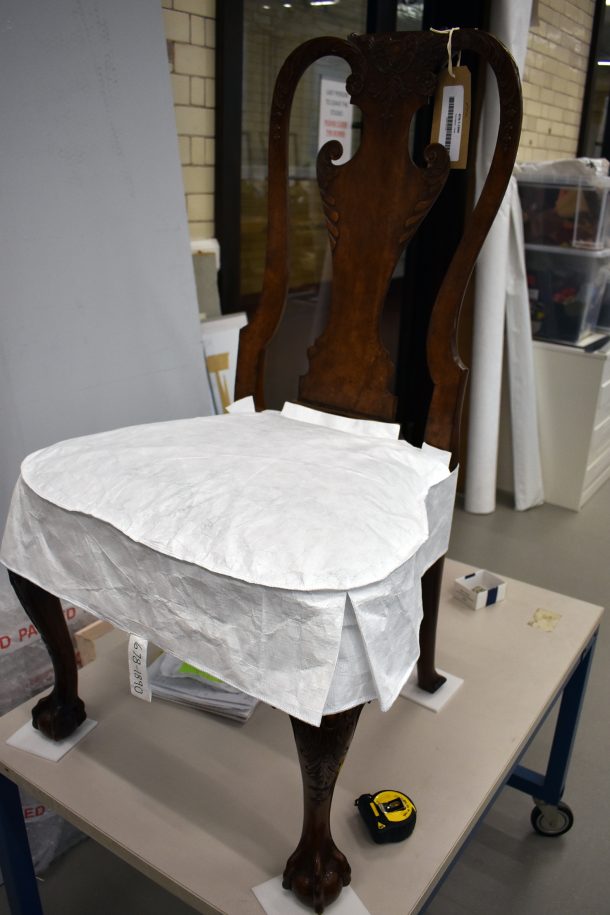by Isobel Harcourt BSc, MCULMC
Upholstery Conservator, Blythe House Decant Project
Blythe House, which has been the Victoria and Albert Museum’s main store for four decades, is scheduled for redevelopment necessitating the removal of the collections to a new campus currently being built in East London. The V&A furniture store at Blythe House contains over 1000 objects with textile components including seat furniture, desks, worktables, cabinets, fire screens, and sedan chairs. As part of the decant project these objects need to be prepared for a significantly different storage environment at the new Collection and Research Centre (CRC). The new store will be public facing: visually accessible from viewing areas on two levels, with public routes reaching partway into the racking. Textiles are vulnerable to increases in light, airflow, and display soiling that come with an open storage environment. Moreover, many store objects have textiles in a condition that it would not benefit the institution to display without mediating interpretation.
The decision was taken to provide covers for all furniture with exposed textiles. However full covers have two disadvantages in the context of relocation and open storage. They might mask vulnerable elements such as delicate carving or hanging trim, and increase the risk of accidental damage during handling. They might also obscure the object, reducing the impact of the visitor experience. It was agreed that covers were necessary but, where possible, only the textiles should be covered, leaving the frames exposed. The covers have to be breathable (to prevent the formation of microclimates), structurally durable, and chemically stable (as they would be in long-term contact with the object).
A significant number of objects have upholstery that is of low significance due to being non-original or in very poor condition, others have robust textiles in good condition. It was decided that Tyvek covers would be appropriate for many of these and budgetary savings from using Tyvekwould allow more resources to be focussed on the most vulnerable and significant textiles in the collection. These would have down-proof cotton covers fitted, with silk habotai linings where appropriate.
A pool of volunteers was recruited at the beginning of the decant project to assist across the various collections. At the beginning of 2019 three volunteers, who had been working in the furniture stores assisting with audits and barcoding, were assigned to help with the conservation programme one day per week. Although they had little sewing experience it was decided that they should work on the Tyvekcovers as this could be done with minimal supervision.
Following training on the studio sewing machines and domestic overlockers they were introduced to basic pattern cutting and machining. Tyvek requires minimal finishing and has an obvious grain that is helpful for lining up pattern pieces. The team began by making tabard covers for the fire screens. By the time these were completed they had gained confidence in measuring, machining, and fitting and were ready to move on to more complex objects.

Dining chairs with upholstered seats make up the largest class of objects in the upholstered furniture collection and require relatively small, simple covers that are easily fitted (Figure 1). The objects themselves are generally small enough to be easily brought into the studio. The team began work on late eighteenth and early nineteenth century chairs as these have similar proportions, and three basic patterns drawn up by the conservator could be adapted to fit most of them. Starting with seat covers for the least complicated chair types (without arms or curved profiles), the team concentrated on finding simple ways of fitting the covers around stiles and back splats (Figure 2).

At this point two more volunteers were recruited. With a pool of five to draw from, four were able to attend most weeks. Working in pairs was found to be the most effective use of time and studio equipment. Once pattern measurements were drawn up, one in each pair would cut and fit, and the other machine. This division of tasks with a rotating workforce allowed each team member to stay with their strengths or move between tasks depending on personal preference.
As the team gained experience they became relatively autonomous, freeing the conservator to work on more complex studio projects. Moving onto armchairs and less regular seat shapes they developed a repertoire of pattern features to draw from. Every few weeks a side project was identified to give some variety and a chance to see a different part of the collection. These included covers for sedan chairs, footstools, and twentieth-century sofas (Figure 3).

The curatorial team was keen to improve the labelling in the store to make objects easier to identify on the high racking. Each cover was clearly marked with the object accession number, written using broad chisel nibs to allow it to be easily read at a distance. Vulnerable elements such as hanging trim, loose joints, or glass panels were marked up with ‘caution’ labels.
Over the course of a year the volunteer team produced 178 covers. Unfortunately on 16th of March 2020 the UK went into lockdown in response to the rise of COVID-19 and practical work at Blythe House ceased. Conservation staff returned on 20th of July but unfortunately funds were not available to make up the months lost to the project, and it was not considered safe to bring volunteers back on site before the November finish date. Despite these setbacks almost 90% of the whole collection now have permanent covers. Most of those that remain uncovered are lower priority objects.
Postscript: to maintain a safe working environment during the pandemic, the Textile Conservation team based in South Kensington split into two separate cohorts resulting in the re-deployment of several conservators to Blythe House to help with the decant project. The project to cover the upholstered furniture collection is now almost complete.
Acknowledgements
Thanks are due to the wonderful volunteer team – Sue Owen, Junko Weetman, Lucy Wilmott, Melinda Harper, and Dee Shock. Nora Brockmann and Hannah Sutherland are completing the project.


